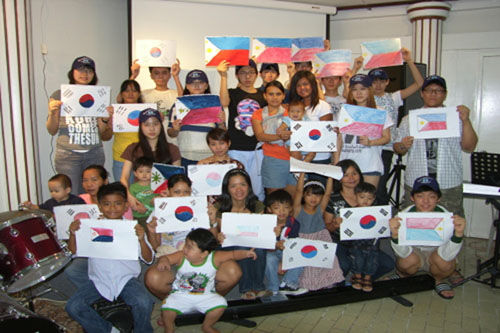The Case of Kopino Children
<#320 Feature>
Abandoned Korean Children Seek Recognition
: The Case of Kopino Children
By Rigoberto Banta Jr., Head Student Editor
“Did they choose this fate?”
Mr. Darcy Kim, President of Newsgate, the first Korean magazine in the Philippines, talks about the plight of the Kopino children. ‘Kopino’ refers to the children born of Korean fathers and Filipino mothers. These children, together with their unwed mothers, are abandoned by their Korean fathers and left without any clear sight of the future. “These children, most of them having no memory of their fathers, live in poverty partly because their mothers solely provide for their needs and that the mothers are ashamed of what other people might think about them: temporary toys that Korean men can just throw away at their whim”, Mr. Kim explains.

Numbers Escalate Through Tourism
The Philippines has experienced a boom in Korean tourists in the islands and with it the increase of Kopino children as well. According to the statistics of the Philippine Department of Tourism, almost 740,000 Koreans have visited the Philippines, the biggest group of foreigners to visit the country occupying 21 percent of the whole tourism industry in the country. As a result of most of them entering short-term courses in English or for general tourism, many Korean men are enticed to have pleasure without considering the possible consequences after the fact.
However, this is not a new issue in the Philippines. As tourism flourishes in the country, sex tourism has popped up as a by-product, whereby many Filipino women work as guest relations officers, bar girls and prostitutes. This coincides with the fact that prostitution is illegal in the predominantly Roman Catholic country.
This has taken its toll on the Filipino women having illicit affairs with foreign men and bearing illegitimate children. Before the Kopinos, there was a surge of around 50,000 so-called ‘Amerasian’ children, those born of American fathers and Filipino mothers, especially in the northern part of the Philippines where the presence of the U.S. military bases, until 1992, fuelled sex tourism in the said area. The numbers of ‘Japinoys’, born of Japanese fathers and Filipino mothers, was quite large as well in the 90’s.
There are currently around 10,000 Kopinos in the Philippines nationwide. According to statistics, most of them are concentrated around Quezon City, Cebu City and in Angeles City.
Mr. Kim explains that the increase of these children can be attributed to two factors. The first factor is the increased prosperity of South Korea and the availability of resources to go abroad to either travel or study. The second factor is the motive of the Korean men going to the Philippines to temporarily ease the pressures of Korean society and ‘living their lives’ where most of the time money for sex is involved. Once they know that their temporary girlfriend is impregnated, they abandon them and deny that the child is theirs. Without the recognition of their fathers, the children have very little chance of getting support from either the Philippine or Korean governments.
No recognition of children fathered by Korean men to non-Koreans rings a bell to this reporter. Can this be an issue to be related with the looming xenophobia in Korean society against multicultural families?
Hope against All Odds: Education Is the Key
According to the statistics from the Korean Ministry of Foreign Affairs and Trade, the Philippines houses about 100,000 South Korean expatriates. With this huge number of South Koreans in the Philippines deciding to stay for a longer time, support groups have been formed to address the issue, although the Korean community does not generally pay attention to it.
In Cebu, for example, The Kopino Children Association, established in 2009 by Korean business in the area, takes care of about 23 families by paying regular visits and providing basic needs. Another organization, The KopinoChildren Foundation pays regular visits at a very meagre donation rate of only about 300,000 Korean won monthly, barely enough to cover transportation fees for the volunteers.
In Quezon City, another Kopino Children Association helps Kopino children to get back on track to education by providing classes for them as well as basic Korean language and culture sessions to them and their mothers. On the other hand, since 2009 in South Korea, the Korean Youth Exchange Promotion Association, has started to invite the children and their mothers to Korea since 2009 to understand Korean culture more and strengthen the identity of the children.
“Without proper attention, the future of the children is bleak. However, for now, educating these children to bring out their highest potential is very crucial” says Mr. Kim of Newsgate. As the Kopino children grow and become catalysts of change in both the Philippine and Korean society, may we not give the same wounds that Korea has received before its development and let the wounds of the past be a testament to Korean society that it should be vigilant to stop such atrocities against humanity?
Rigoberto Banta Jr. 기자
rj.banta@yahoo.com.ph

